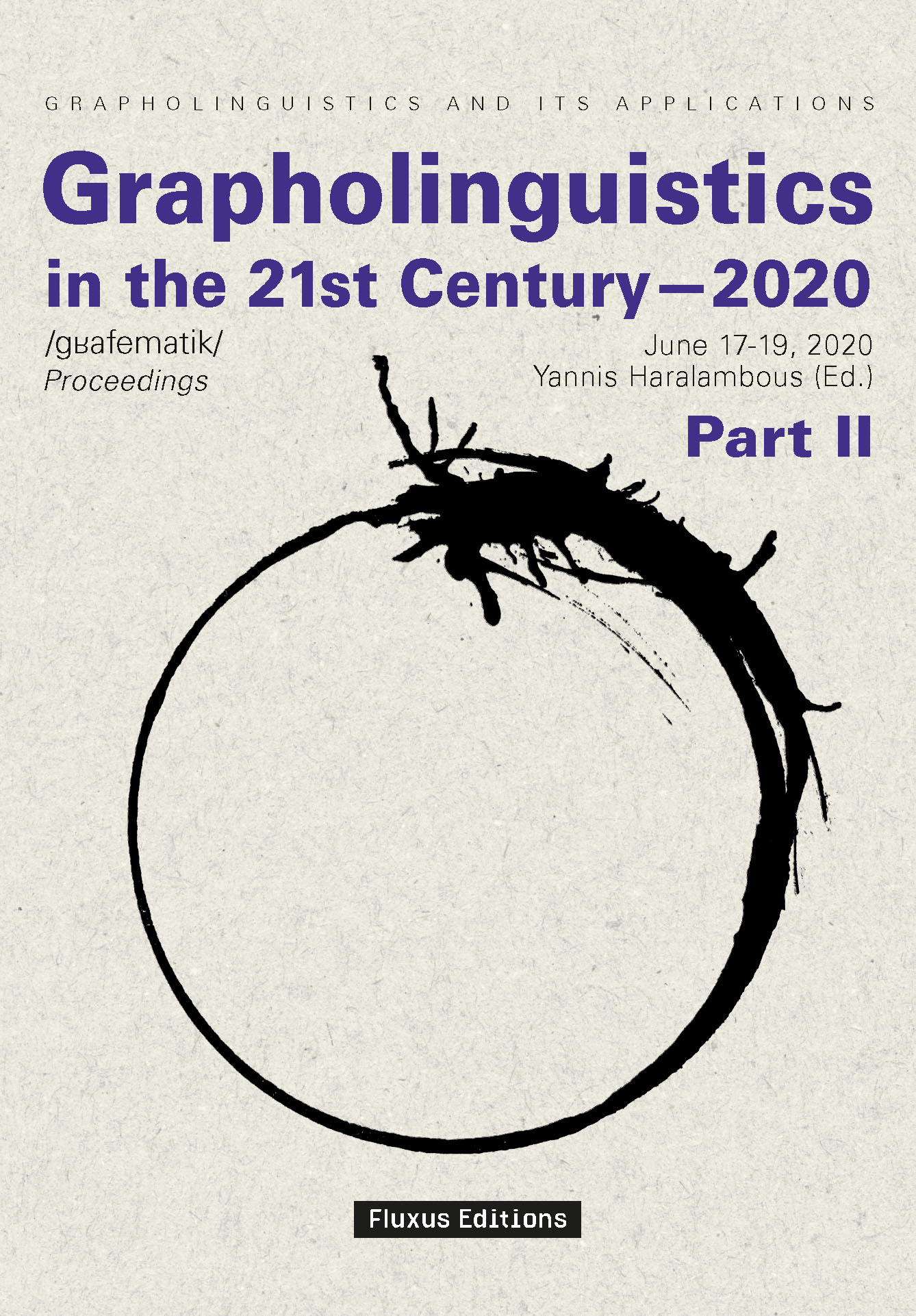
 ISSN: 2534-5192 (electronic) – 2681-8566 (print)
ISSN: 2534-5192 (electronic) – 2681-8566 (print)
 ISSN: 2534-5192 (electronic) – 2681-8566 (print)
ISSN: 2534-5192 (electronic) – 2681-8566 (print)| ◀ H. Giunashvili | ▲ Proceedings | P. Kelly ▶ |
 ISBN: 978-2-9570549-7-8 e-ISBN: 978-2-9570549-9-2  | On the Typology of Writing Systems Liudmila L. Fedorova  Abstract. The paper aims to propose a scheme for classification of writing systems, based on four binary characteristics of spelling: linear vs. non-linear spelling, integral vs. segmental one, complete vs. reduced, simple vs. differentiated spelling. The main attention is given to the non-linear emblematic writing, namely to Aztec script, which shows the examples of linguistic emblems—the first readable writing signs for place names and proper names. Further development of writing explores the techniques of segmentation and differentiation that contribute to the refinement of spelling, yet they go along with a trend to reduced and integrated forms, so we have today the coexistence of emblems-emoticons, Chinese characters and highly differentiated alphabets. DOI: https://doi.org/10.36824/2020-graf-fedo
@INPROCEEDINGS{berdan1997b,
AUTHOR = {Berdan, Frances F.},
EDITOR = {Berdan Frances F. and Anawalt, Patricia Rieff},
TITLE = {The Place-Name, Personal Name, and Title Glyphs of the Codex Mendoza: Translations and Comments},
BOOKTITLE = {The Essential Codex Mendoza},
PUBLISHER = {University of California Press},
ADDRESS = {Berkeley},
YEAR = {1997},
VOLUME = {1},
PAGES = {163--239},
}
@INPROCEEDINGS{berdan1997a,
AUTHOR = {Berdan, Frances F. and Anawalt, Patricia Rieff},
TITLE = {Glyphic Conventions of the Codex Mendoza},
BOOKTITLE = {The Essential Codex Mendoza},
PUBLISHER = {University of California Press},
ADDRESS = {Berkeley},
YEAR = {1997},
VOLUME = {1},
PAGES = {93--102},
}
@ARTICLE{berlin1958a,
AUTHOR = {Berlin, Heinrich},
TITLE = {El glifo “emblema” en las inscripciones mayas},
JOURNAL = {Journal de la Société des Americanistes},
YEAR = {1958},
VOLUME = {47},
PAGES = {111--119},
}
@ARTICLE{bradley2009a,
AUTHOR = {Bradley, David},
TITLE = {Language policy for China's minotities: Orthgraphy development for the Yi},
JOURNAL = {Written Language \& Literacy},
YEAR = {2009},
VOLUME = {12},
NUMBER = {2},
PAGES = {170--187},
}
@ARTICLE{bright2000a,
AUTHOR = {Bright, William},
TITLE = {A matter of typology: Alphasyllabaries and Abugidas},
JOURNAL = {Study in the Linguistic Sciences},
YEAR = {2000},
VOLUME = {30},
NUMBER = {1},
PAGES = {63--71},
}
@INPROCEEDINGS{daniels1996,
AUTHOR = {Daniels, Peter T.},
EDITOR = {Daniels, P. and Bright, W.},
TITLE = {The study of writing systems},
BOOKTITLE = {The World's Writing Systems},
PUBLISHER = {Oxford University Press},
ADDRESS = {New York},
YEAR = {2009},
PAGES = {3--17},
}
@ARTICLE{daniels2009,
AUTHOR = {Daniels, Peter T.},
TITLE = {Two notes on terminology},
JOURNAL = {Written Language \& Literacy},
YEAR = {2009},
VOLUME = {12},
NUMBER = {2},
PAGES = {258--274},
}
@INPROCEEDINGS{dyakonov,
AUTHOR = {Dyakonov, Igor M.},
AUTHOR_ORIGINAL = {Дьяконов, Игорь М.},
AUTHOR_ORIGINAL+AN = {1=ru-Cyrl},
EDITOR = {Dyakonov, Igor M.},
EDITOR_ORIGINAL = {Дьяконов, Игорь М.},
EDITOR_ORIGINAL+AN = {1=ru-Cyrl},
TITLE = {\textrussian{Протошумерские иероглифы} [Proto-Sumerian hieroglyphs]},
BOOKTITLE = {\textrussian{Тайны древних письмен: Проблемы дешифровки} [The mysteries of ancient scripts: Problems of deciphering]},
PUBLISHER = {Прогресс [Progress]},
ADDRESS = {Москва [Moscow]},
YEAR = {1976},
PAGES = {569--571},
}
@ARTICLE{elkins2003a,
AUTHOR = {Elkins, James},
TITLE = {Four ways of measuring the distance between alchemy and contemporary art},
JOURNAL = {HYLE---International Journal in Philosophy and Chemistry},
YEAR = {2003},
VOLUME = {9},
PAGES = {105--118},
}
@ARTICLE{fedorova2009a,
AUTHOR = {Fedorova, Liudmila},
TITLE = {The Emblematic Script of the Aztec Codices as a Particular Semiotic Type of Writing System},
JOURNAL = {Written Language \& Literacy},
YEAR = {2009},
VOLUME = {12},
NUMBER = {2},
PAGES = {258--274},
}
@ARTICLE{fedorova2012a,
AUTHOR = {Fedorova, Liudmila},
TITLE = {The development of structural characteristics of Brahmi script in derivative writing systems},
JOURNAL = {Written Language \& Literacy},
YEAR = {2012},
VOLUME = {15},
NUMBER = {1},
PAGES = {1--25},
}
@BOOK{j1963a,
AUTHOR = {Gelb, Ignace J.},
TITLE = {A study of Writing},
PUBLISHER = {Chicago University Press},
ADDRESS = {Chicago},
YEAR = {1963},
}
@BOOK{istrin1965,
AUTHOR = {Istrin, Viktor A.},
AUTHOR_ORIGINAL = {Истрин, Виктор А.},
AUTHOR_ORIGINAL+AN = {1=ru-Cyrl},
TITLE = {Возникновение и развитие письма [The appearance and development of writing]},
PUBLISHER = {Наука [Nauka]},
ADDRESS = {Москва [Moscow]},
YEAR = {1965},
}
@ARTICLE{lee2009a,
AUTHOR = {Lee, Sang-Oak},
TITLE = {The Korean alphabet: An optimal featural system with graphical ingenuity},
JOURNAL = {Written Language \& Literacy},
YEAR = {2009},
VOLUME = {12},
NUMBER = {2},
PAGES = {202--212},
}
@ARTICLE{perri2014a,
AUTHOR = {Perri, Antonio},
TITLE = {Why writing is not (only) transcribing? Writing codes in contact: steps towards multigraphic literacy practices},
JOURNAL = {Testo e Senso},
YEAR = {2014},
VOLUME = {15},
PAGES = {75--98},
}
@BOOK{rogers2005a,
AUTHOR = {Rogers, Henry},
TITLE = {Writing systems: A linguistic approach},
PUBLISHER = {Blackwell Publishing},
ADDRESS = {Malden, MA and Oxford, UK},
YEAR = {2005},
}
@BOOK{sim-a,
AUTHOR = {Siméon, Rémi},
EDITOR = {Wimmer, Alex},
TITLE = {Dictionnaire de la langue nahuatl ou mexicaine},
PUBLISHER = {Akademische Druck- u. Verlagsanstalt},
ADDRESS = {Graz, Austria},
YEAR = {1963},
}
@BOOK{sullivan1983a,
AUTHOR = {Sullivan, Thelma D.},
TITLE = {Compendio de la Gramática Nahuátl},
PUBLISHER = {Universidad National Autónoma de México},
ADDRESS = {México},
YEAR = {1983},
}
Liudmila L. Fedorova (2020), “On the Typology of Writing Systems,” in Proceedings of Grapholinguistics in the 21st Century, 2020 (Yannis Haralambous, Ed.), Grapholinguistics and Its Applications, Vol. 5, Brest: Fluxus Editions, 805–824.
@INPROCEEDINGS{gla5-fedo,
AUTHOR = {Liudmila L. Fedorova},
EDITOR = {Haralambous, Yannis},
TITLE = {{On the Typology of Writing Systems}},
BOOKTITLE = {{Proceedings of Grapholinguistics in the 21st Century, 2020}},
SERIES = {{Grapholinguistics and Its Applications}},
VOLUME = {5},
PUBLISHER = {Fluxus Editions},
ADDRESS = {Brest},
YEAR = {2020},
PAGES = {805--824},
DOI = {https://doi.org/10.36824/2020-graf-fedo},
}
|